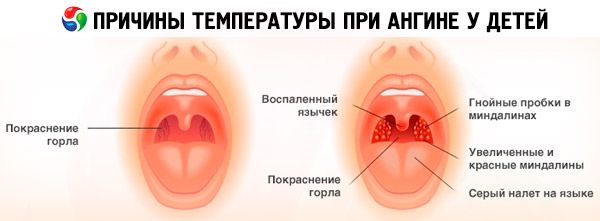Medical expert of the article
New publications
Temperature in sore throat in children: what to do and how to bring down?
Last reviewed: 04.07.2025

All iLive content is medically reviewed or fact checked to ensure as much factual accuracy as possible.
We have strict sourcing guidelines and only link to reputable media sites, academic research institutions and, whenever possible, medically peer reviewed studies. Note that the numbers in parentheses ([1], [2], etc.) are clickable links to these studies.
If you feel that any of our content is inaccurate, out-of-date, or otherwise questionable, please select it and press Ctrl + Enter.

Tonsillitis is quite common in preschool children. Characteristic signs of the disease are weakness, plaque on the inflamed tonsils, and noticeable signs of intoxication. But most often, the greatest concern is caused by elevated temperature with tonsillitis in children, because at the initial stage of the disease it can reach 40 degrees.
Causes of fever in sore throats in children
Usually the cause of the increase in temperature in acute tonsillitis is the appearance of pus in the tonsil lacunae (it appears in the follicular or lacunar form of tonsillitis, and in addition to this, in phlegmonous tonsillitis, which is considered the most severe form of this disease).

Symptoms
There are several different types of tonsillitis, which differ in symptoms and temperature readings.
Follicular type of tonsillitis – the patient has almost the same symptoms as with lacunar tonsillitis. In this case, the temperature increases to about 38-39°C. In addition, with this form of pathology, small pustules (approximately like a match head) form on the tonsils. Sometimes it also appears against the background of lacunar tonsillitis.
Lacunar tonsillitis (in general, this type of pathology and the previous (follicular) are components of one process) involves a "deepening" of the infection and purulent plaque - with it, pus accumulates in the tonsil lacunae. Among the symptoms of the disease are sharp pains in the throat, an increase in the size of the tonsils and the development of an inflammatory process in them, as well as chills, a feeling of weakness and headaches. In this case, the temperature reaches 40 ° C. There are also cases when this form of tonsillitis develops without an increase in temperature - this happens quite rarely, with a weak immune system.
Phlegmonous tonsillitis (also called acute paratonsillitis) is an advanced form. In this case, the pathology affects not only the tonsils - the area around the tonsils also becomes inflamed, as well as the peritonsillar tissue. An abscess (or phlegmon) also forms. In this case, the temperature rises sharply to 39-40+ °C, the patient begins to have chills and severe weakness, and an increase in regional lymph nodes is observed. Usually, in such a case, the temperature normalizes and the patient's well-being improves only after the abscess is opened (this can happen after surgery or on its own).
Temperature with herpetic sore throat in a child
If herpangina develops, the child's temperature immediately rises and a general feeling of malaise occurs. The temperature rises very sharply - just a few hours can be enough for the temperature to jump to 38-39°C.
A universal sign of this type of disease is that there are 2 peaks of temperature increase - on the 1st and 3rd days. With other forms of the disease, there is usually only one peak increase.
How long does the temperature last with tonsillitis in children?
Usually, with angina, the temperature rises quite sharply, but remains at this level only for a short period of time. A gradual decrease begins several days after the onset of the disease. A more precise number of them depends on the form of angina:
- with catarrhal tonsillitis, high temperature persists for 1-2 days;
- for follicular - about 3-4 days;
- in the lacunar form of the disease – approximately 4-5 days;
- for herpetic sore throat – 1-3 days;
- the so-called Simanovsky-Vincent's angina often develops without an increase in temperature, but if it does increase, then this period lasts only 1-2 days.
Diagnostics of fever in sore throats in children
When diagnosing tonsillitis, it is necessary to pay attention to the clinical picture of the disease. During examination, the doctor detects enlargement and hyperemia of the tonsils. In addition, swelling and redness are diagnosed on the palatine arches adjacent to the tonsils. Also, follicles from which pus is released can be seen on the tonsils. Temperature indicators help to determine the specific form of tonsillitis.
Treatment of fever in sore throats in children
First of all, it should be noted that there is no need to try to bring down a temperature that has not risen above 38°C, because such a temperature indicates that the body is able to fight the infection on its own. But if the temperature rises above 38.5°C, it will be necessary to take antipyretic drugs.
How to bring down a child's temperature with tonsillitis?
Physical cooling is also considered an effective method – for example, rubbing with a towel soaked in warm water (at least 37°C). The room temperature should be about 25°C. With proper rubbing, the feeling of cold does not appear. You can use vinegar solutions, although this is a rather dangerous method, since it can lead to unpleasant consequences if the proportions are incorrectly calculated.
Physical cooling methods are suitable only in the case of so-called "pink fever" (in this case, a uniform increase in temperature is observed in all parts of the body, even if the patient's condition is considered satisfactory). In addition, in the case of pink fever, it is necessary to increase heat transfer - do not wrap yourself in blankets and clothes (you should cover yourself with a thin blanket or sheet).
But in the case of "pale fever" the blood circulation in the skin weakens - because of this the patient feels cold under the influence of the temperature from the outside. Therefore, with this type of fever it is necessary to wrap him in warm clothes, a blanket, and also give him warm liquid to drink. In this case, it is recommended to give the patient such medications as paracetamol or analgin. During white fever the temperature should be lowered in any case, because it can cause convulsions or fainting.
In case of tonsillitis, you should not use hot foot baths with mustard, and also do not give the child raspberry tea to drink - this will only provoke an even greater rise in temperature and worsening of the condition.
Medicines
When the temperature rises to more than 38°C, you need to take antipyretic drugs: ibuprofen or paracetamol (for children - in suppositories or syrup), and in addition, analgin. The dosage should be selected depending on the age of the child. In case of angina, you should not bring down the temperature with aspirin, because it can cause such a complication as the development of Reye's syndrome (with it, encephalopathy is observed, as well as steatosis).
Folk remedies
A very important aspect of treating angina is gargling – it allows you to remove pus from the tonsils and wash out pathogenic microbes. For this, various herbal infusions and pharmacy disinfectant solutions are used. A soda solution for gargling with angina can also be used, which has an effective cleansing effect. Gargling should be done every 3 hours.
The patient also needs to drink a lot and abundantly. Rosehip decoctions, as well as cranberry or lingonberry fruit drinks, help to strengthen the body. Thanks to these remedies, immunity increases, kidney function improves, toxins are neutralized and removed. They should be consumed every 2 hours, 0.5 glasses.
It is necessary to rub yourself with warm water, especially in areas where blood vessels are located: on the wrists and neck. Rubbing should be done at a warm temperature, in a room without drafts - hypothermia cannot be allowed.
There is also a method of gradual cooling using a water bath (at the beginning of the procedure, the water temperature should be 37-37.5°C, and then it should be gradually lowered to 33-34°C). This method is based on the so-called "contact" heat loss, which makes it possible to quickly and effectively lower the temperature.
Complications and consequences
The danger of tonsillitis is that it is fraught with serious complications. In addition to peritonsillar abscess, in which the patient can only be helped with surgical treatment, there are many other consequences of this disease.
They can be divided into two separate groups - with general symptoms and local manifestations. Local is purulent lymphadenitis in acute form, developing against the background of cervical phlegmon. Among the general ones, such diseases as myocarditis, rheumatism, infectious form of polyarthritis, sepsis, as well as meningitis and pyelonephritis are distinguished.
Thus, after successfully curing a sore throat, it is mandatory to have blood and urine tested twice, and in addition to this, have an ECG done - you need to finally make sure that the disease has not caused complications.
Prevention
To prevent angina, it is necessary to boost immunity using various methods. Special immunostimulating drugs, such as immunal or imudon, have an effective effect on the immune system. You can also strengthen the body in a natural way - proper nutrition, exercise, gymnastics, etc.
It is also necessary to promptly eliminate the causative agents of chronic infections - dental caries, suppuration in the paranasal sinuses, as well as chronic tonsillitis. In addition, it is necessary to rid the child of problems that interfere with nasal breathing - often these are adenoids.
Forecast
Temperature during angina in children most often has a favorable prognosis - with proper and timely treatment. But if the disease is often repeated - this can be the cause of the development of quite unpleasant complications.


 [
[